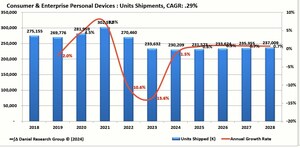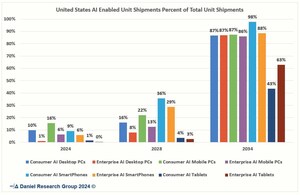BELMONT, Mass., April 20, 2021 /PRNewswire/ -- Daniel Research Group, a market research firm specializing in economic and market forecasting, announces the availability of its free updated United States Business Economic Demographic Forecast Report. The report contains essential information and data that business decisions makers require in facing today's many challenges.
Total Available Market
According to Steve Daniel, President of Daniel Research Group, "COVID-19 has altered the structure of the US economy more than any other event since World War II." In this rapidly changing economic environment, business executives are struggling to make immediate critical decisions about asset allocation and investments, product and service development, as well as marketing tactics and strategies, that align with new market dynamics. This free report will provide them with a better understanding of their markets.
At some point in the forecasting process for products and services marketed to companies, the size and growth of the Total Available Market (TAM) needs to be estimated. For most products and services, the user and/or buying decision maker is an employee within the business or business sub-unit. Daniel Research Group (DRG) maintains and continually updates a Business Economic Demographic Database (BEDD) that contains the history from 1998 and a forecast to 2026 of Employees, Businesses, Establishments, and Payroll by Sector (Public and Private), Sub-Sector, Industry and Business Size (Employees). BEDD was designed to help our clients size and forecast the total available market for their products and services. It provides the answer to three fundamental planning questions.
- How big is the market for my product or service?
- How fast is it growing?
- How is it segments by Sector, Sub-Sector, Industry and Business Size?
Structural Changes
By of the end of 2020, almost nine million people had lost their jobs, 41% of them previously employed in small business, and over 450 thousand business will have permanently closed, (98% with under 100 employees).
These structural reallocations reflect fundamental changes in consumer, employee, and employer behaviors that have, and will continue, to alter demand for many products and services. The two most important manifestations of these changes are:
- The significant decrease in the number of small businesses
- The major shifts in the distribution of labor across industries, firm sizes, and place of work
Downshift
In addition to these factors, the normal downshift in employment levels following an economic shock will shape the length and speed of economic recovery. Furthermore, unlike many prior shocks, the COVID-19 shock disproportionally impacted specific industries, firm sizes, and more importantly, occupations.
Employment will not return to pre-COVID-19 until 2024 or later. During the Oil Shock recovery (1992-2001) employment was 5.7% below the pre shock level. During the Dot Com recovery (2003 -2009) employment was 3.6% below the pre shock level. During the Great Recession recovery (2010-2019) employment was 8.0% below pre shock levels.
Our models estimate the average employment downshift will be 7.1% over the next 5 years and 7.9% over the next 10 years. We expect that 49% of the Jobs lost and 22.4% of the Business lost in 2020 will recovered by the end of this year. However, the degree of recovery will vary significantly by industry and size class.
Work From Home
The persistence of work from home post COVID-19 is open for debate. There is wide range of estimates across the surveys we have reviewed. For guidance we looked at past equivalent infrastructure changing events. In most cases the long-term net productivity benefit took some time to be realized as supporting and derivative infrastructures needed time to adapt.
Our own assumptions expressed in our models is that the percent of employees working from home will continue to decline in the short term as COVID-19 restrictions are lifted and people begin to return to pre COVID behaviors. However, the new work from home percentage will remain higher than pre COVID as many employees and employers will elect to continue to work from home. By the end of 2025, the number of employees working at fully or partially from home will have increased by 90% over the Pre COVID-19 level.
Contact:
Steve Daniel, President
Daniel Research Group
(617) 484 – 6225
[email protected]
www.DanielResearchGroup.com
SOURCE Daniel Research Group

Related Links
WANT YOUR COMPANY'S NEWS FEATURED ON PRNEWSWIRE.COM?
Newsrooms &
Influencers
Digital Media
Outlets
Journalists
Opted In






Share this article